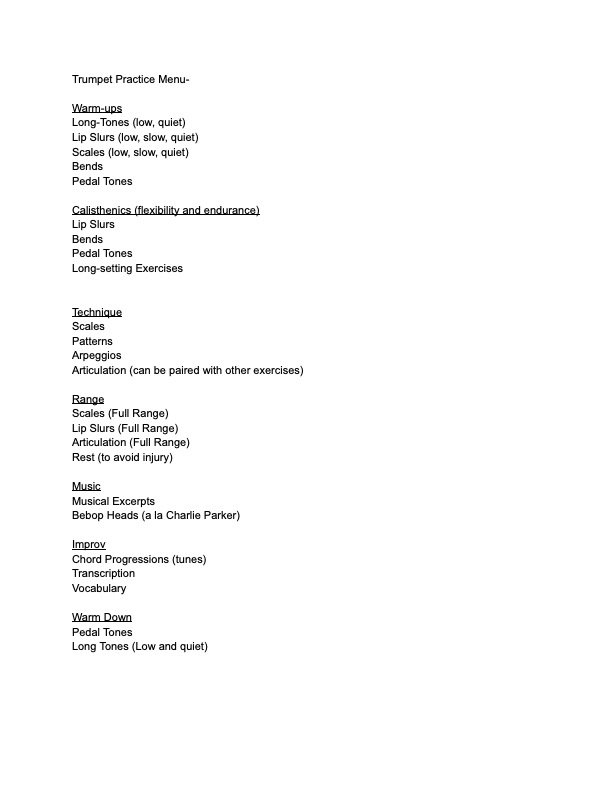Mechanical Voicings
An educational resource for “Mechanical Voicings” for five horns. Includes explanations for different basic voicing types, rules for arranging, and approach reharmonization. Sample harmonization of “Ornithology” included.
Chord Scales and Modes
This is accompanying materials from my video on “Chord Scales”, including a sheet with the Chord Scales to the Jazz Standard “There Will Never Be Another You”, and the modes and names for Major, Melodic Minor, and Harmonic Minor Scales.
Trumpet Practice menu
This is my trumpet “Practice Menu”, a resource for trumpet players to use in the development of a personalized practice routine. Accompanying Youtube Video .
Charts
This is some of the sheet music I’ve amassed of years of transcription and composition.
Transcriptions
Roy Hargrove’s Solo on “Brian’s Bounce”, off the album Family, 1995.
The recent loss of the Roy Hargrove has set the entire Jazz world in a state of grief and shock. Every musician that frequents jam sessions at Smalls or Zinc Bar has memories of Roy, entering sessions to show everyone the true meaning of music making. I remember growing up listening to him, seeing him live at Yoshi’s Jazz Club in Oakland.
Brian’s Bounce is a Db blues, and, to me, is a small showcase of what made Roy’s playing special. His lines are clear, clever, and tasteful. He doesn’t overplay. His phrasing, above all else, is perfect. Every note is meaningful in it’s melodic, harmonic, and rhythmic functioning, and speaks to the soul of Jazz.
Nicholas Payton, Roy Hargrove, and Wynton Marsalis’ solos on “The Three Trumpeteers” off of Payton’s 1998 album Payton’s Place"
This was one of my favorite albums in my middle and high-school years, and this track was a special treat; to hear three of my trumpet idols play back to back was inspiring. Each soloist contrasts well with the other two, highlighting exactly what makes each unique. Wynton show-cases a rhythmically intriguing motivic solo that starts and ends on the same unique melodic fragment. Payton is at his acrobatic best, playing octave displaced lines and powerful blues vocabulary. And Hargrove plays tasty, swinging, and with perfect phrasing. After some trading (with the inevitable “Range Check”) The rhythm section drops out for a chorus, leaving the three trumpeteers to play a-capella, in a beautiful show of harmonious improvisation.
I tried my best in this transcription, but their were some difficulties, most of which came in trying to notate the rhythms for Wynton’s chorus of improvisation. He has a unique approach to time in this solo, stretching the beat like an elastic band that always snaps back in place. It’s a technique I now would like to emulate, but the notation was a nightmare for me. I wanted to avoid the use of odd subdivisions (fivelets and sevenlets) as I didn’t feel they would convey the intent of the solo, so I decided to do the best I could with simpler notation, but occasional written direction (laid-back, gradually slowing down, etc.) Definitely listen to the original if you plan on using my transcription (as you should any time you are learning a solo!)
Tom Harrell’s Solo on “Chasing the Bird”, off of John McNeils’s album Look to the Sky, 1996
Tom Harrell has always been one of my favorite improvisers. I have always believed that Bach and Bebop shared more than a first letter, and Tom Harrell’s improvising expresses exactly why I believe that. The lines Harrell plays conveys the melodic-harmony perfectly; expressing the inner voice-leading of the underlying harmony in a way that is both beautiful and virtuosic.
John Swana’s Solo on “Oleo”, off of his album John Swana and Friends, 1991
It wasn’t until a student mentioned John Swana to me that I realized how amazing an improviser and trumpeter he is. His lines are clever, unique, and well thought out. His moments of chromaticism always resolve appropriately, he superimposes interesting harmonies and rhythms, and he isn’t afraid to play the blues. I love transcribing rhythm changes, because it’s always a great representation of a Jazz musicians language. Here is his solo on Sonny Rollin’s “Oleo”, be sure to check out the recording to hear his hip arrangement of the tune with him and fellow trumpeter Tom Harrell playing the melody in perfect fifths.
Original Music
Scores for study are available for free, if you’re interested in purchasing parts,
please contact me for rates.
Bye Polar Bear
I wrote this piece for jazz orchestra during my time at New England Conservatory. The pun in the title refers to the two distinct styles of the piece. I was experimenting with different harmonic and melodic ideas, using stark contrasts of dark and light. The beginning section is an exercise in counterpoint based harmony- each new voice added was written to be melodically satisfying as well as harmonically fitting.
Jazzschool Babies-
Written in ode to the Jazzschool in Berkeley California, where I took classes and lessons in my formative years. The piece features a simple metric modulation (dotted quarter in three becomes the new quarter note in four) which underscores the two contrasting sections of the piece.
A Gathering Storm-
written in 2016, this piece in 6/8 was originally arranged for quintet (trumpet, tenor, piano, bass, drums), but this version was arranged for the inclusion of alto sax and guitar. The most characteristic features of the piece are the repeating ostinato arpeggiations in the piano, and the way the horn melody interweaves within it.
Fire Breather-
This is a graceful, melodically driven straight eights piece, with separate solo sections. While writing this, I had the mental image of a beautiful woman dancing and playing with fire- spitting it out of her mouth and spinning it in different majestic ways. This was my attempt to convey the emotions surrounding this mental image.











